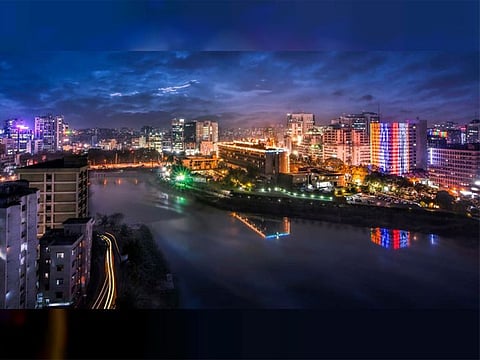Here is Bangladesh’s paradox: Good economics, not so good politics
In literacy rate alone, Bangladesh is far ahead of Pakistan and has come closer to India

When Bangladesh got its independence in 1971 after a nine-month-long, violent civil war, Henry Kissinger had contemptuously referred to it as a ‘basket case’. In 1974, the New York Times predicted that Bangladesh was becoming a ‘Malthusian Nightmare’ as its population will outgrow the food that the country can grow. After 50 years of independence, Bangladesh has proved its doomsayers wrong.
Bangladesh is often referred to as a success story as it boasts several impressive statistics in the economic and social sectors. At the same time, questions are being raised about the health of democracy. In the last week, Reporters without Borders has even included the Prime Minister of Bangladesh in its 2021 list of ‘Predators of Press Freedom’.
Despite the decline of democracy, the economy of Bangladesh is doing well, and it has been consistently outperforming its South Asian counterparts. Its GDP per capita has gone up to $2,227, while in Pakistan, the country from which it was separated in 1971, is only $1,543. Even in India, where some nationalists have made the alleged illegal migration from Bangladesh a huge political issue, the per capita income is less at $1947.
Lending a helping hand
In May 2021, when Sri Lanka was facing trouble maintaining its depleting foreign reserve, Bangladesh even extended a $200 million currency swap facility to help the Lankan economy. Bangladesh is so confident that after the World Bank cancelled the one-billion-dollar loan contract in 2012 for the Padma Bridge due to allegations of corruption, it built the mega bridge with its own funds.
Since 1990, the average GDP growth of Bangladesh has been higher than the average GDP growth of the world, and for over a decade, Bangladesh has been averaging better than the South Asian average. After a recent economic downturn in India, Bangladesh is the leading performer in economic growth in South Asia.
Aided by the booming manufacturing sector and its garment industry, Bangladesh has already graduated in 2015 to be counted as a lower-middle-income nation. Bangladesh is also becoming a power player in the export of software and IT services. As per the UN estimate in 2018, Bangladesh, the largest Least Developed Country (LDC) globally in terms of population and economic size, is expected to move out of the LDC category by 2024.
The country, which was being predicted to suffer from mass starvation in 1974, has already achieved self-sufficiency in food production for its 166 million population. The number of people living under extreme poverty in the country is reducing significantly. Its 2.5 million overseas migrant workforces also support the country’s economy by sending money home. In 2020 alone, Bangladesh received $19.8 billion from remittances.
Investing smartly in public services
The impressive achievement of Bangladesh is not only limited to the economy, but the country is also doing well in the social sector as it has been investing smartly in public services and narrowing the social and gender distances. In 1960, the fertility rate in Bangladesh and Pakistan was the same, 6.7 per woman, and in India, it was 5.9.
After 60 years, in 2020, Bangladesh had reduced its fertility rate to 2, while India had 2.2 and Pakistan had 3.4. Improved spending in the health sector shows that Bangladeshis are also living longer than Indians and Pakistanis. In 2018, life expectancy in Bangladesh was 72.32 years, while in Pakistan, it was 67.11 years, and in India, it was 69.42 years.
In literacy rate, Bangladesh is far ahead of Pakistan and has come closer to India. More significantly, compared to India, Bangladeshi girls are ahead in higher educational attainment than boys. In the participation of women in the labour force, Bangladesh also outperforms India.
Priority for education and health care
The government in Bangladesh prioritises its expenditure on education and health care compared to other South Asian countries. From nutrition to sanitation, from education to empowerment, Bangladesh’s progress has been remarkable in recent decades.
While the world needs to praise the success of Bangladesh in economic and social sectors, it also needs to be aware that the country’s slide from democracy could reverse the trend. Bangladesh has witnessed at least three military coups in the past, in 1975, 1982, and 2007.
Country’s hard-fought democratic journey received a major setback in 2011 as it scrapped the practice of holding elections under a non-partisan caretaker government. That led to the boycott of the 2014 general election by the largest opposition party.
Since then, the opposition in Bangladesh has been marginalised. The 2018 election gave Prime Minister Sheikh Hasina a third consecutive term. The country’s main opposition leader and former Prime Minister Khaleda Zia has been given a 17-year jail term on charges of embezzling donations.
The absence of opposition and lack of parliamentary oversight has raised questions over the quality of governance. Corruption has become a serious problem as it ranks as one of the most corrupt nations by Transparency International.
The threat of religious extremist groups has lessened to some extent due to the government’s recent crackdown. Bangladesh also faces the burden of sheltering almost a million Rohingya refugees, and their return soon doesn’t look very promising. India’s National Registry of Citizens in its state of Assam has also raised a similar fear among Bangladeshis.
Bangladesh has indeed made praiseworthy progress in economic and social development in recent years. However, its democracy without effective opposition could reverse its successes. To circumvent that eventuality, Bangladesh needs to relook at its politics seriously.
Sign up for the Daily Briefing
Get the latest news and updates straight to your inbox







